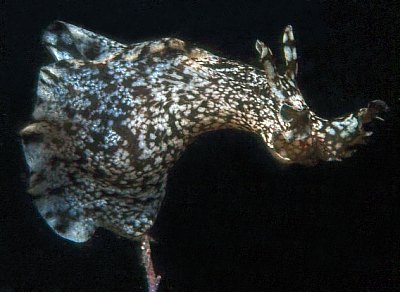
Aplysia kurodai
(Baba, 1937)
Order: ANASPIDEA
Superfamily: APLYSIOIDEA
Family: Aplysiidae
DISTRIBUTION
Japan, Korea, China
PHOTO
Sogwipo, Cheju Island, South Korea; depth of
20 meters; March, 2001. Photo: Dong Bum, Koh.
Dark brownish or purplish-black and covered with a variable scattering of whitish translucent spots and patches. Secretes both purple and white ink, parapodia large and separated posteriorly. Grows to 30cm in length.
Reference:
• Baba, K., (1937) Opisthobranchia of Japan (I). Journal of the Department of Agriculture, Kyushu Imperial University, 5(4): 195-236. (Pl.4)
Rudman, W.B., 2002 (June 12) Aplysia kurodai (Baba, 1937). [In] Sea Slug Forum. Australian Museum, Sydney. Available from http://www.seaslugforum.net/find/aplykuro
Related messages
Sea Hares in Taiwan
October 30, 2006
From: Vincent Y. Chen
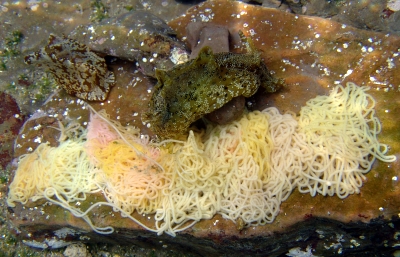
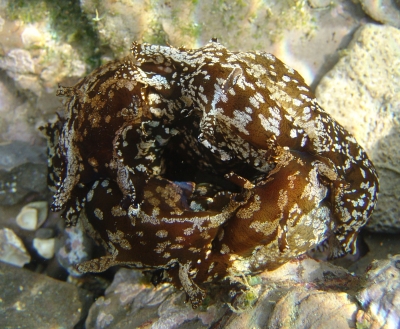
Concerning message #16419:
Dear Bill,
Here attached a few photos of sea hares in Taiwan.
Locality: Ma-Gong sea platform, 30 cm, Taipei, Taiwan, West Pacific Ocean, 12 Feb. 2006, Intertidal rocks. Length: 6~8 cm. Photographer: Vincent Y. Chen.
The last two ones are related to mating behavior. On your Mating chains page you write "Sea Hares, like all sea slugs, are hermaphrodite animals with fully functional male and female reproductive organs. Sometimes, usually in dense populations or in crowded aquariums, they form mating chains of three or more animals, the one at the front acting solely as a female and the one at the rear solely as a male. The animal(s) in between are acting as both males and females."
I observed a circle happened here. If they are mating, are all of them play the role of both male and female? Would they die after mating? Because I also observed some of dead sea hares after peak season.
Thanks!
Vincent Y. Chen
teatai@ms51.hinet.net
Chen, Y.-W., 2006 (Oct 30) Sea Hares in Taiwan. [Message in] Sea Slug Forum. Australian Museum, Sydney. Available from http://www.seaslugforum.net/find/17917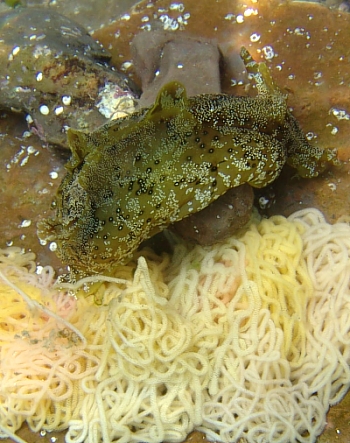
Dear Vincent,
Thanks for these photos. There are two species in your photos. On the left in the top photo there is Aplysia kurodai, which is also the species forming the mating ring in your second photo. The animal on the right in the top photo - and in the bottom photo - is A. oculifera. Aplysia oculifera is easily identifiable from the white spots ringed in dark brown, which resemble eyes and give it the name oculifera [= 'carrying eyes' in Latin].
Concerning your questions, they can certainly act as both male and females when in mating chains. Have a look at the Mass Mortality page for a discussion on mass deaths after breeding.
Best wishes,
Bill Rudman
Aplysia extraordinaria ? from Korea
February 27, 2006
From: Dong Bum Koh
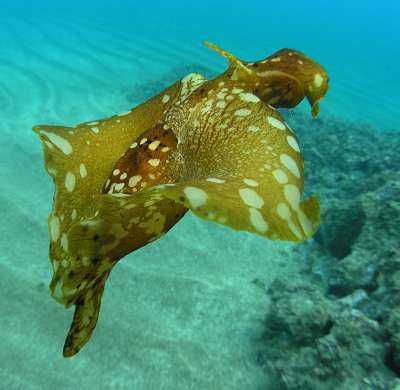
Dear Bill,
On my first day of diving for 2006 in Jeju, we found this swimming seahare which I think is Aplysia extraordinaria. However I'm not sure as its the first time in my life I have seen it. Could you let me know the correct identification?
Locality: Hwa Soon. Jeju, -4m, Korea, Pacific, 19 Feb. 2006, --. Length: estimated 20 - 30 cm. Photographer: Sang Yul Shin.
Best regards,
Dong Bum Koh
drkoh@seasee.co.kr
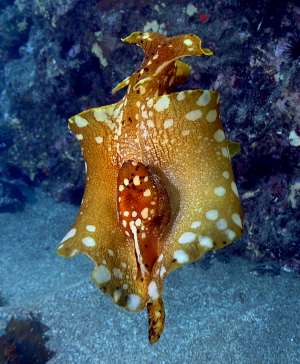
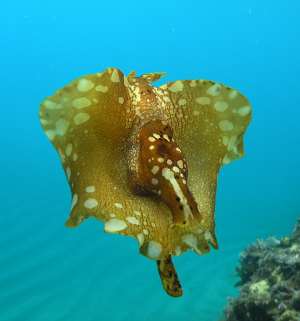
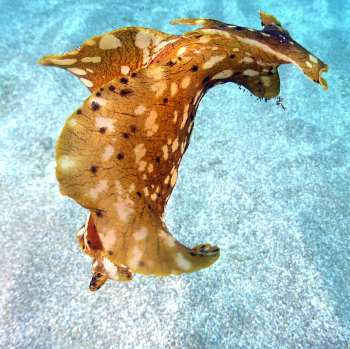
Dear Koh,
Thanks for these spectacular photos. It certainly looks quite similar to A. extraordinaria, and as I have said before, its possible that there is one large swimming Aplysia throughout the Indo-West Pacific. However at present A. extraordinaria is only known from Australia.
It is possible that this is a colour form of Aplysia kurodai. The white patches on the inside edge of the parapodia, and the white patches on the mantle covering the shell, are identical to those in a painting in Baba, 1949 (Opisthobranchia of Sagami Bay). Do you know if A. kurodai swims? I'm afraid this is one of those times when I have to say we just don't know enough about about these animals to be sure. I am almost certain that the animal from Japan in Jun Imamoto's earlier message [#9129], which is sitting uncomfortably with A. californica, is the same as your species.
Best wishes,
Bill Rudman
Shell visible in Aplysia kurodai
June 7, 2005
From: Dong Bum Koh
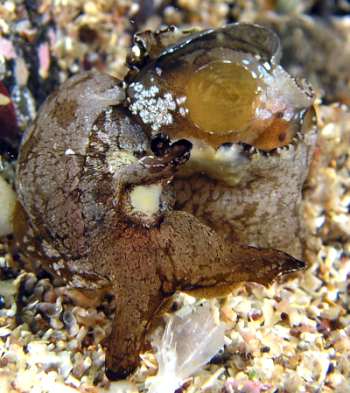

Dear Bill,
I observed the rudimentary shell of living Aplysia kurodai.
Usually it is not visible. Can you suggest any reason why it is so visible?
Locality: Hwa Soon. Jeju island, South Korea. Depth: 4 m. Dec. 2004. Sandy bottom. Photographer: Byung Ro Yun
Best regards,
Dong Bum Koh
drkoh@seasee.co.kr
D. B. Koh, 2005 (Jun 7) Shell visible in Aplysia kurodai. [Message in] Sea Slug Forum. Australian Museum, Sydney. Available from http://www.seaslugforum.net/find/13918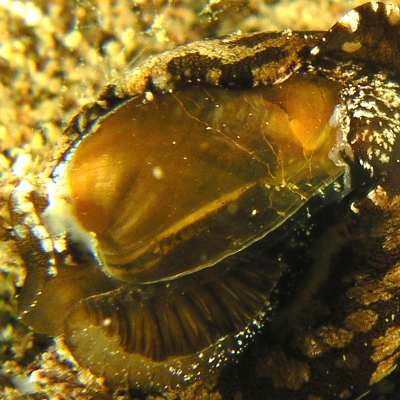
Dear Koh,
I think something has damaged this animal - perhaps something has tried to eat it. In the upper photo there is a large white patch on the head which looks very much like a bite. In the photo alongside the shell is cracked and the mantle on the right side (nearest the viewer) has been ripped, torn or bitten off. my feeling is that these animals are dying, or at least damaged.
Best wishes,
Bill Rudman
Aplysia kurodai from Korea
June 19, 2002
From: Ronald Noseworthy

Dear Bill,
Thanks for your earlier comments. Here is a photo of A. kurodai from Chejudo, Korea, photographed by Dr. Koh. I hope you can use it.
Sogwipo, Cheju Island, South Korea; depth of
20 meters; March, 2001. Photo: Dong Bum, Koh.
All the best!
Ron
globalmark@canada.com
Noseworthy, R., 2002 (Jun 19) Aplysia kurodai from Korea. [Message in] Sea Slug Forum. Australian Museum, Sydney. Available from http://www.seaslugforum.net/find/7299Thanks Ron,
This is clearly the same species as Okutani (2000) identifies as A. kurodai from Japan. It is still hard to be sure how many species of Aplysia there are in the Indo-West Pacific at present, but I have not seen this colour pattern elswhere but in the NW Pacific so it is possibly endemic to the region. I look forward to hearing of your research work.
Best wishes,
Bill Rudman
Aplysia kurodai & A. juliana
June 14, 2002
From: Ron Noseworthy
Dear Dr. Rudman,
I am living on Cheju Island, South Korea. I am studying the molluscs of the island and am currently working on Aplysia. I am trying to determine whether or not A. kurodai is a separate species or a synonym of A. juliana. Okutani, [Marine Mollusks in Japan, 2000] lists both species, and states that A. juliana secretes only a white fluid but A. kurodai secretes a purple fluid. Also, the parapodia are fused posteriorly in A. juliana but not fused posteriorly in A. kurodai.
Any information you can give me would be greatly appreciated.
Ron Noseworthy,
Sogwipo, Chejudo,
Republic of Korea.
globalmark@canada.com
Dear Ron,
In my reply to Tony Wright's message about an Aplysia from Taiwan, I discuss two species reported by Baba (1937) from Japan (Aplysia sibogae Bergh, 1905 and Aplysia kurodai Baba, 1937) both of which I thought could be colour forms of A. juliana. Both were reported to secrete a white fluid from the opaline gland which is usually only obvious in species like A. juliana which do not secrete purple ink as well. On re-reading Baba's paper I see that although he doesn't mention purple secretions for A. kurodai, he does mention that it has a purple gland and that the parapodia are separated behind. From that I woud conclude that the animal he identified as Bergh's A. sibogae was actually A. juliana and his new species, A. kurodai, is not.
Apart from the fused posterior lobes of the parapodia and the lack of a purple gland in A. juliana, that species can also be distinguished by the way the rear part of the foot forms a sucker - the rest of the body often been held above the substrate. Aplysia juliana is very variable in colour, ranging from a uniform black to light brown with whitish patches.
In short A. kurodai is definitely distinct from A. juliana. The photo in Okutani, (if correctly identified), of A. kurodai certainly looks distinctly dfferent from other speces of Aplysia I have seen alive. However producing purple ink and having the parapodia separate posteriorly, are characters found in most species of Aplysia. Until someone is able to review the genus worldwide I cannot say whether A. kurodai is endemic to Japan and other parts of the NW Pacific, or whether it is a more widely spread species and so may have an earlier name from somewhere else. Some photos of this animal would be much appreciated, and any news on your research activities would be very welcome.
Reference:
• Baba, K., (1937) Opisthobranchia of Japan (I). Journal of the Department of Agriculture, Kyushu Imperial University, 5(4): 195-236. (Pl.4)
Best wishes,
Bill Rudman.
